Abstract
1. The circulatory response following acute loss of 26% of the blood volume was examined in unanaesthetized rabbits. The groups of animals studied were normal rabbits; adrenalectomized rabbits; animals subjected to prolonged treatment with guanethidine in which peripheral adrenergic nerve transmission is blocked, but which can reflexly liberate adrenal medullary hormones; animals subjected to combined adrenalectomy and guanethidine treatment with no functional adrenergic effectors; in each case with or without administration of atropine. The responses of animals with section of the carotid sinus and aortic nerves were also examined.
2. The spontaneous rate of replacement of the blood volume after haemorrhage by reabsorption of extravascular fluid was the same in all the above preparations, the blood volume returning to normal 3-4 hr after bleeding.
3. The `passive' effects of haemorrhage were examined in animals without functioning autonomic effectors and include a large fall in right atrial pressure and cardiac output, arterial hypotension, no significant change in total peripheral resistance, and a bradycardia of gradual onset. Reflex autonomic effector activity in normal animals minimizes the fall in atrial pressure, cardiac output and arterial blood pressure, and produces a significant increase in total peripheral resistance and tachycardia. Increased sympathetic nerve activity and secretion of adrenal medullary hormones each play an important and complementary part in the normal circulatory response to haemorrhage of the rabbit. There is also reflex reduction in vagal efferent activity.
4. Reflexes from the carotid sinus and aortic arch limit the fall in arterial pressure for the first 4 hr after haemorrhage. These reflexes also account for the tachycardia normally observed after haemorrhage. The baroreceptor reflexes rather than the chemoreceptors appear to be dominant in these responses.
5. Twenty-four hours after haemorrhage the haemodynamic pattern is similar in all preparations irrespective of their autonomic effector status: blood volume, right atrial pressures and cardiac outputs are all elevated, and the arterial pressure has virtually recovered, consistent with the development of hypervolaemic anaemia at this time.
Full text
PDF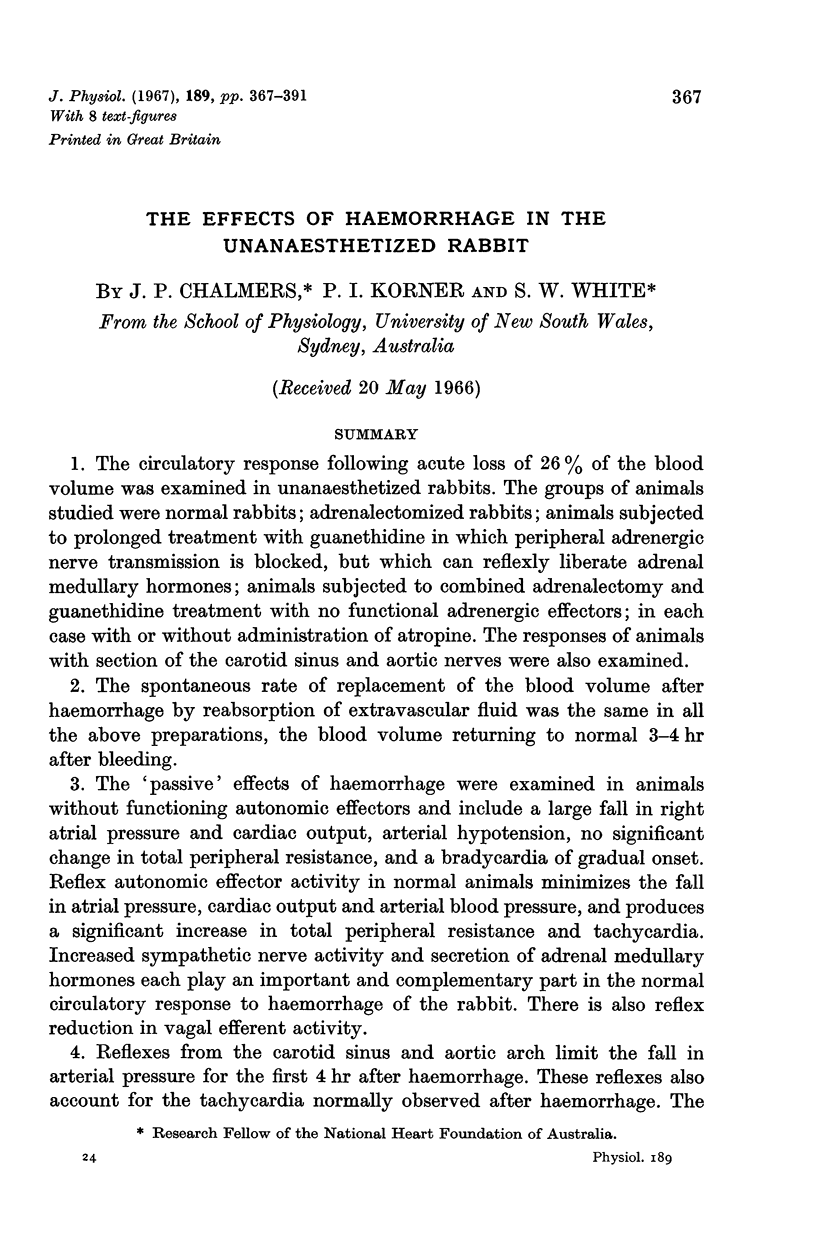
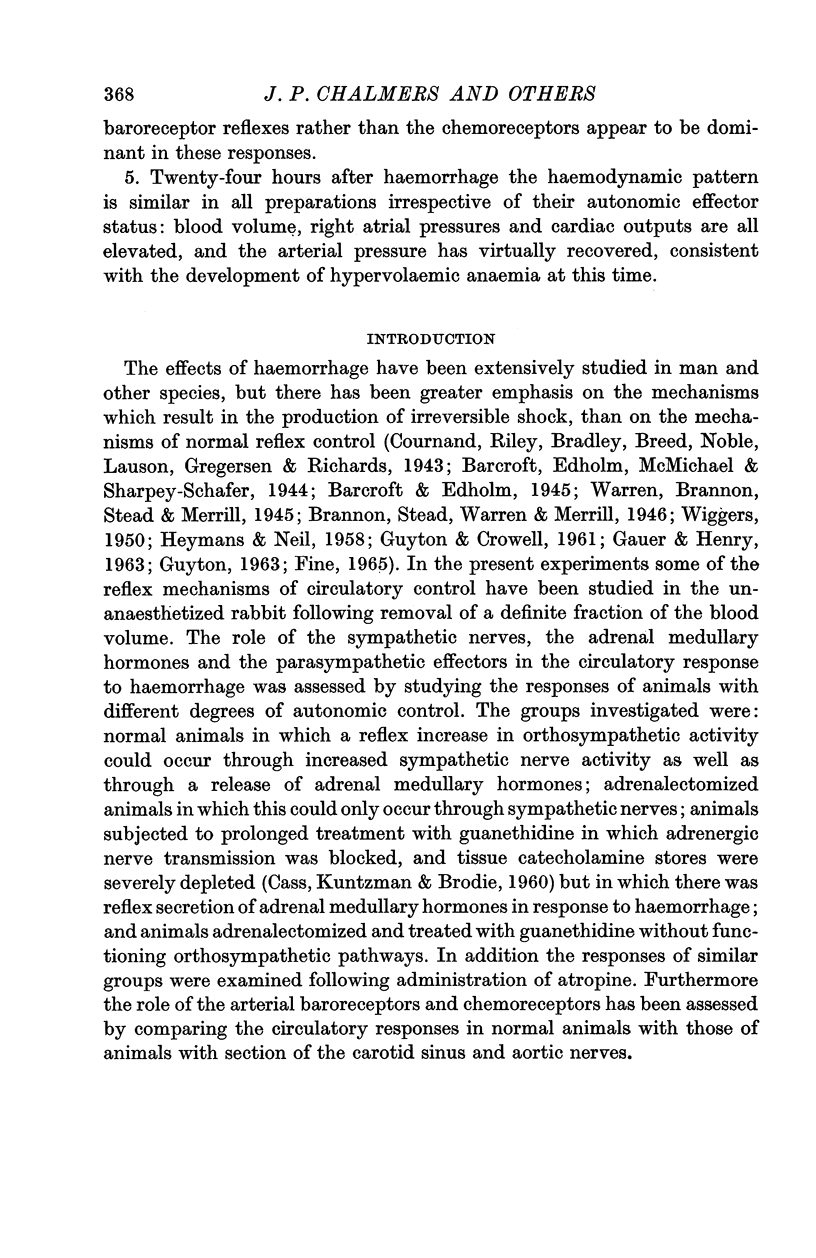
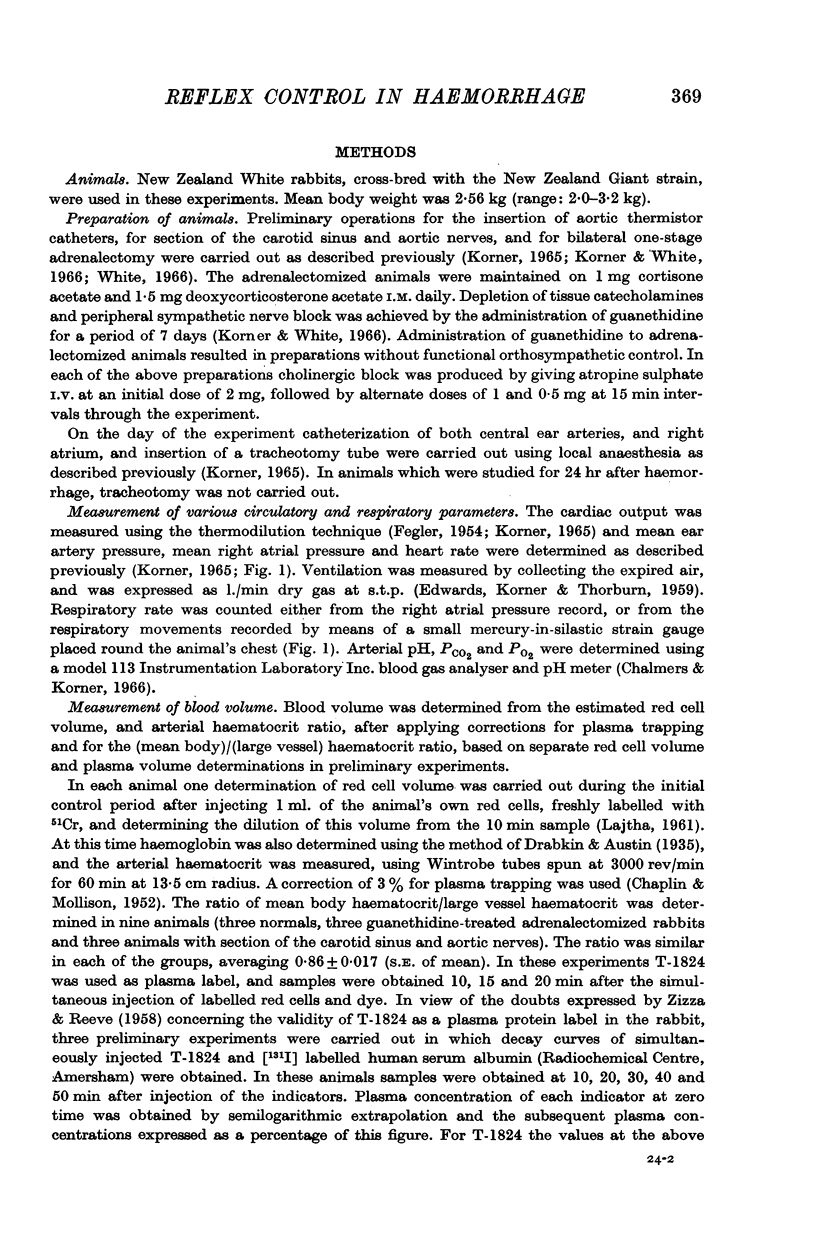
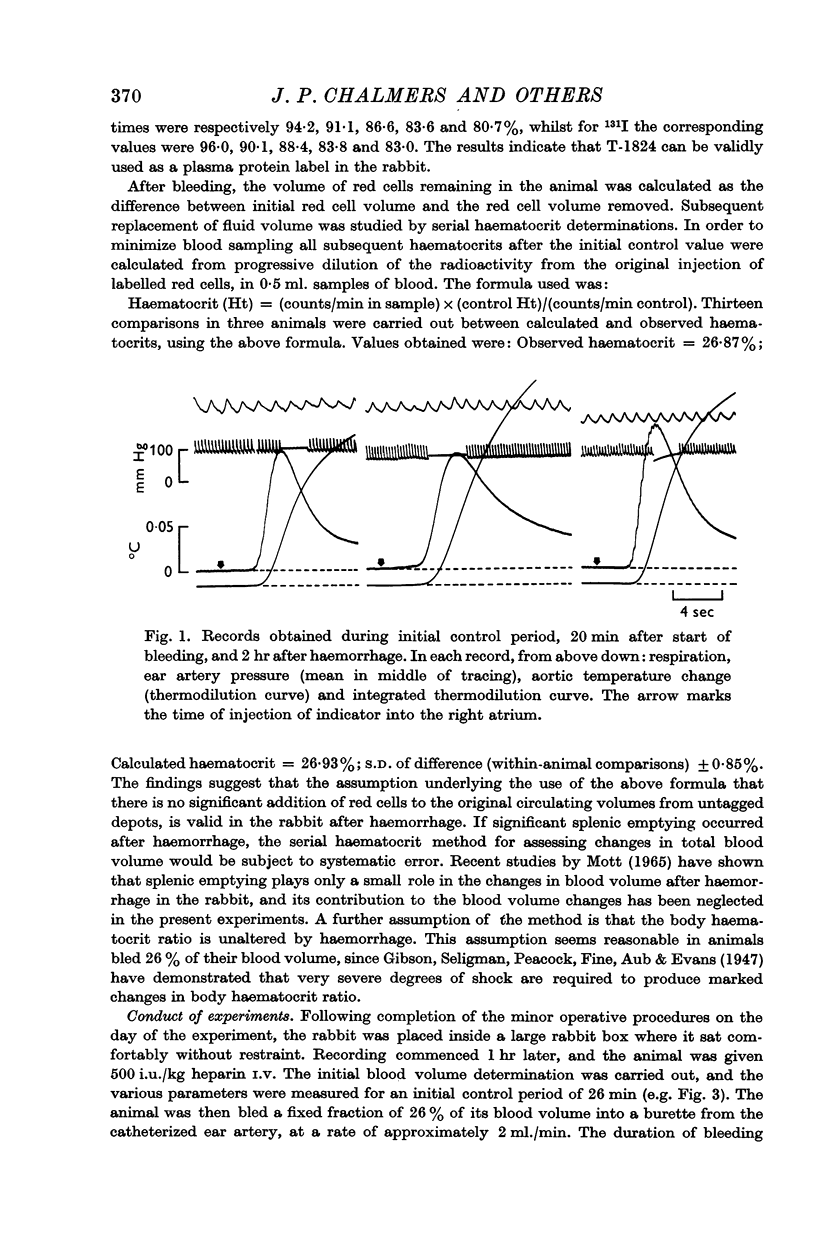
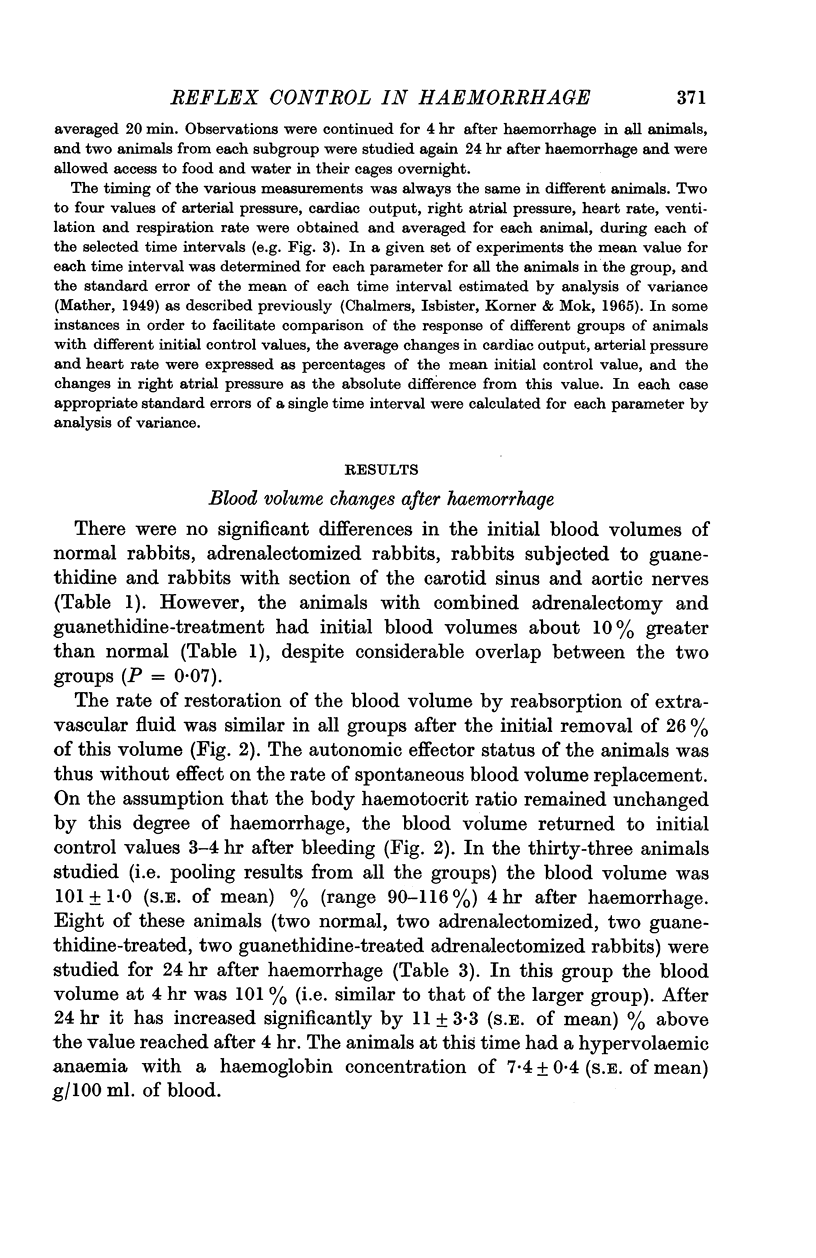
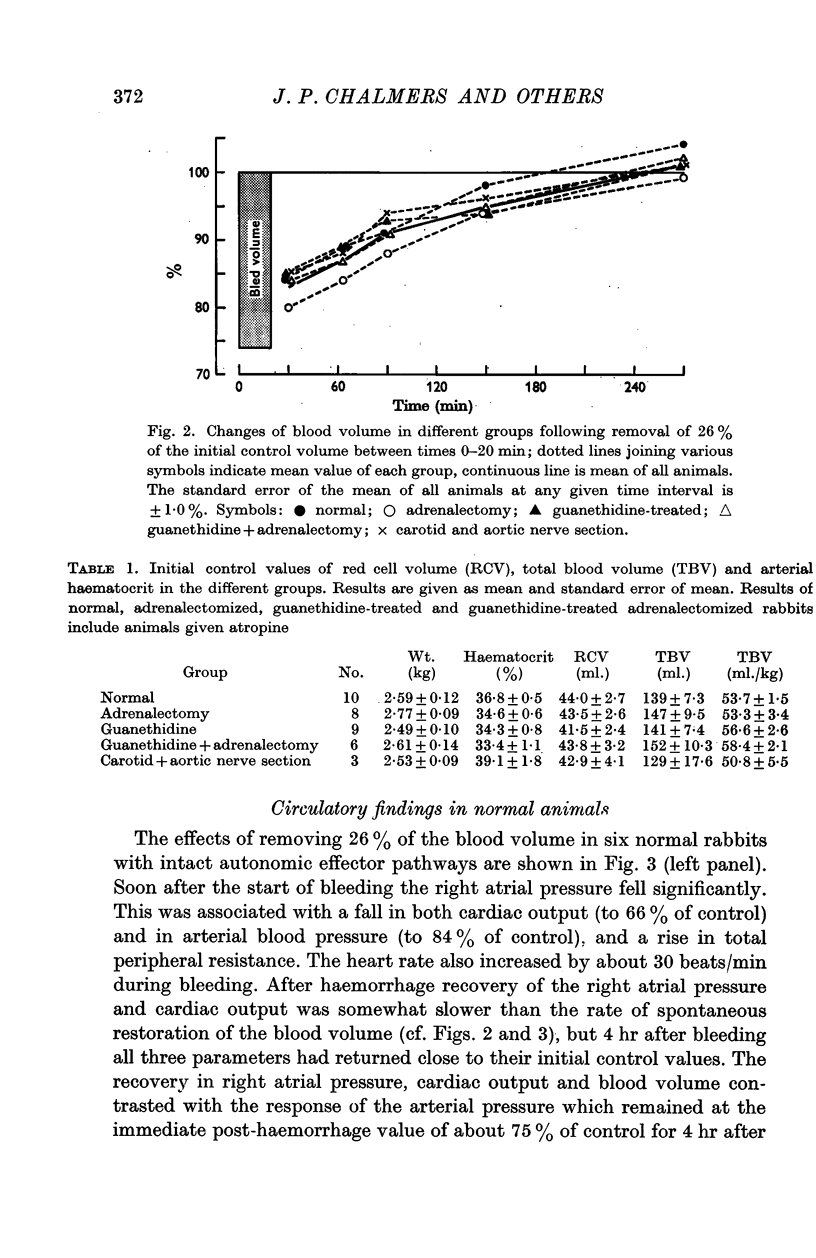
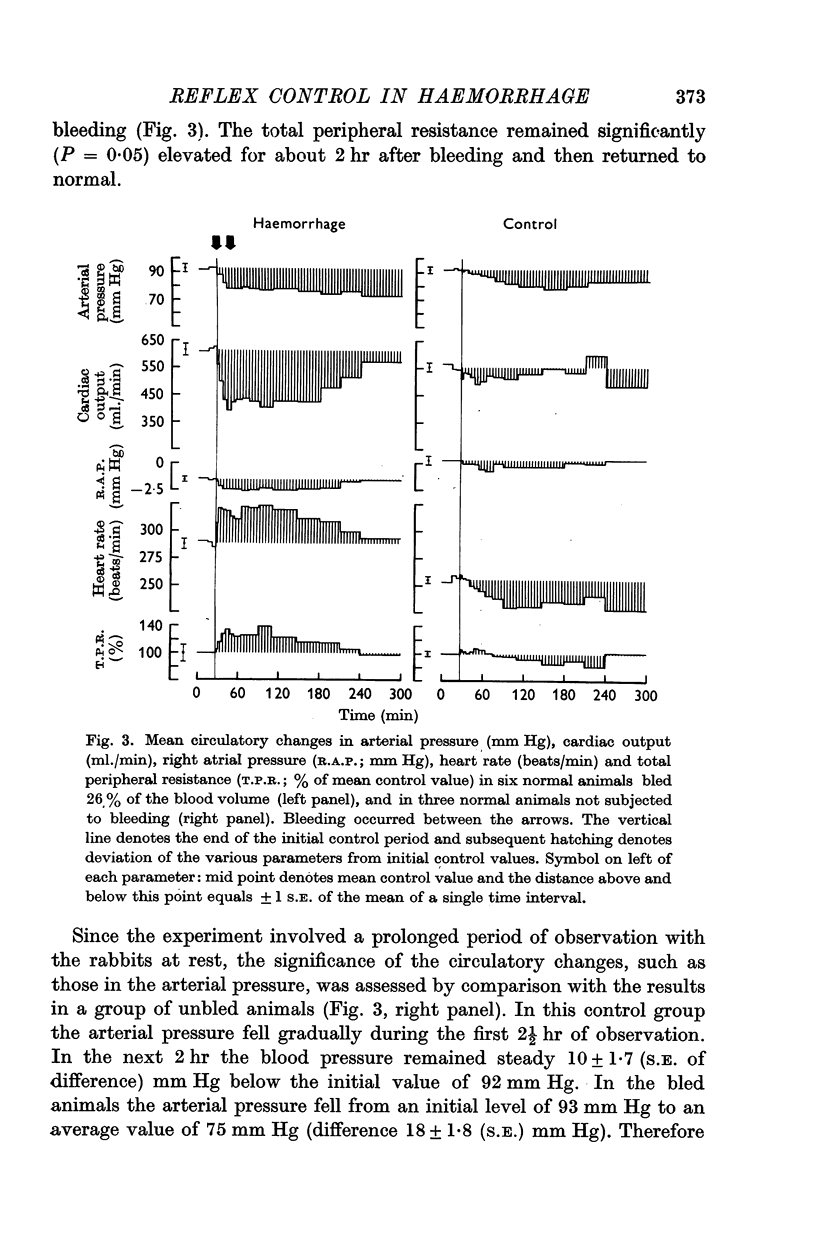
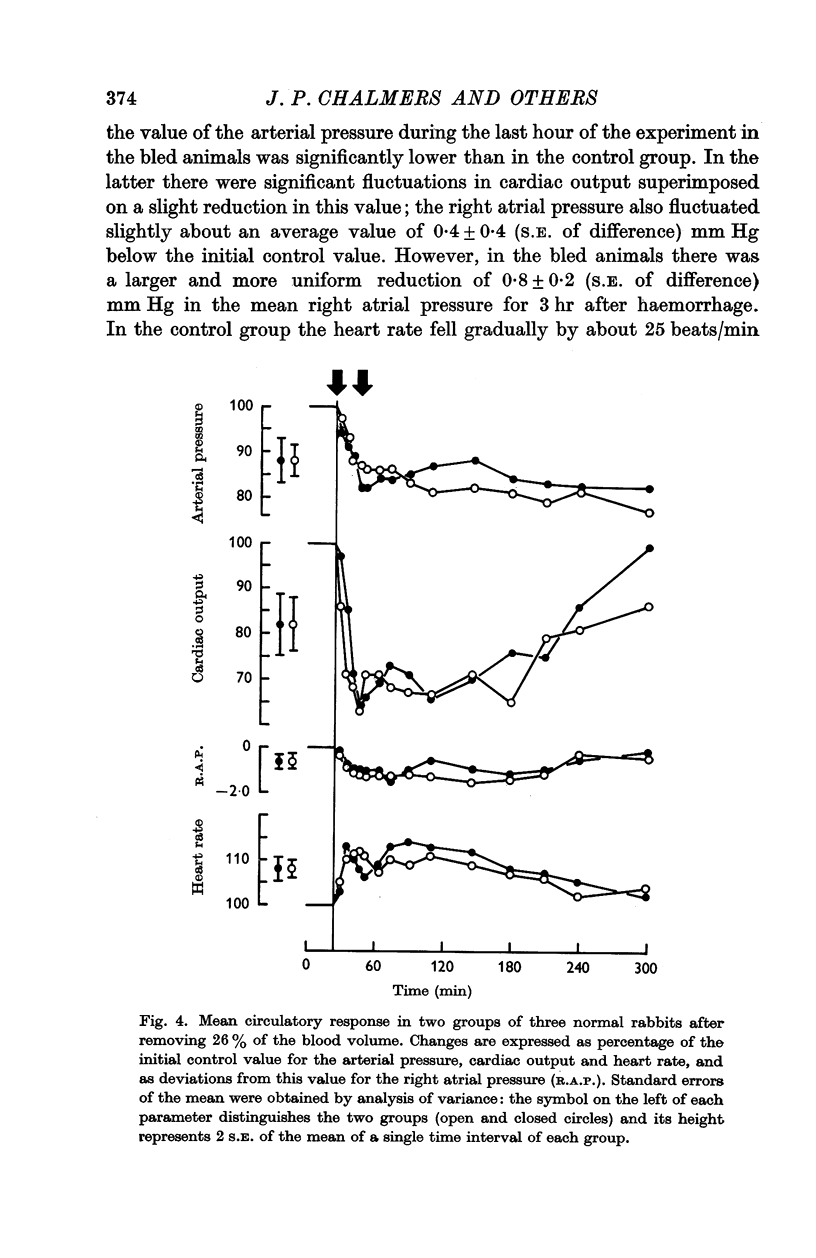
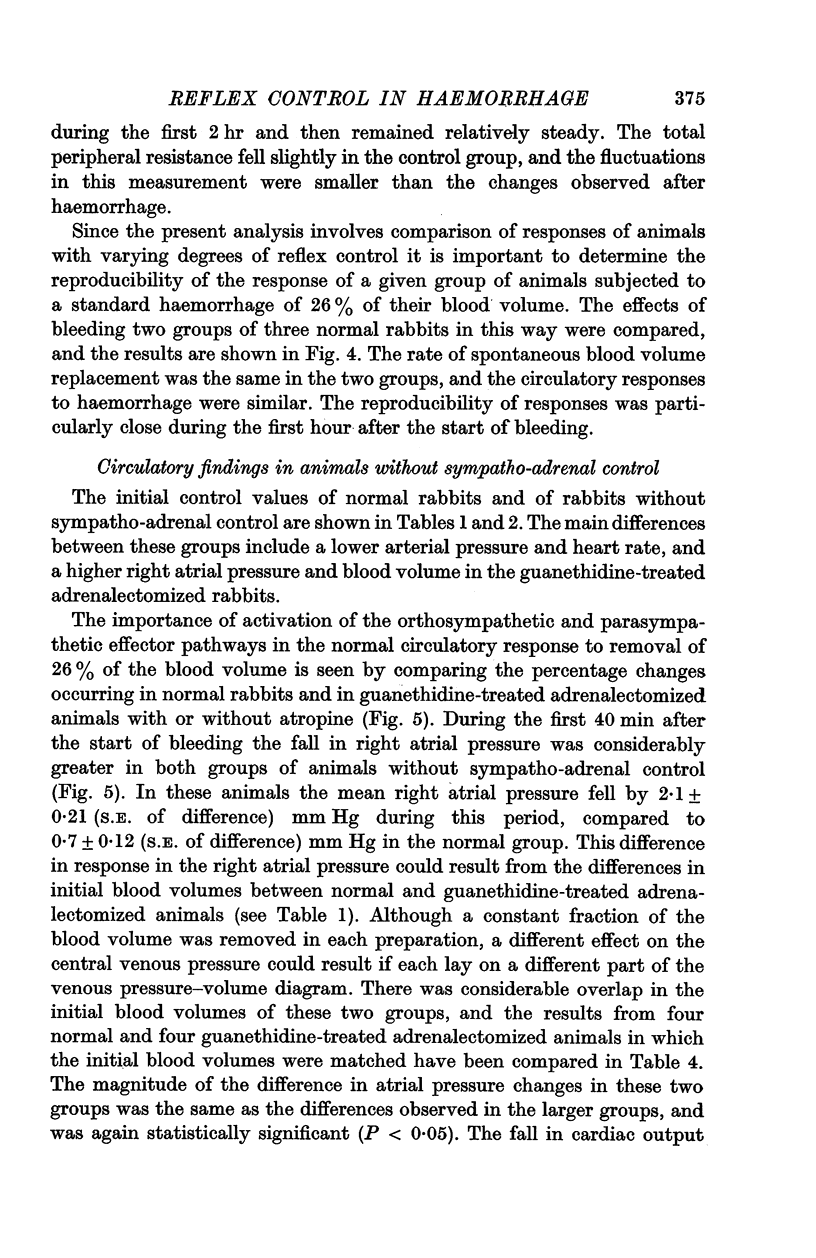
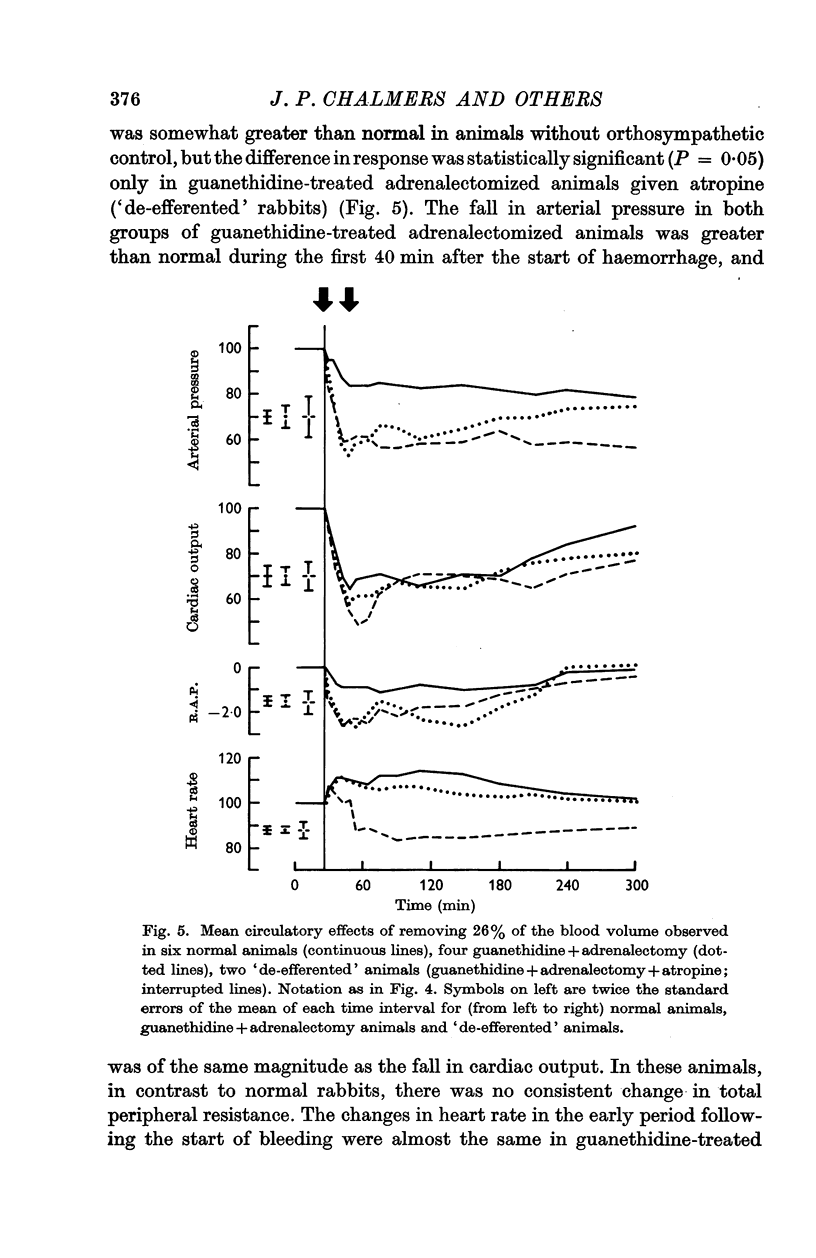
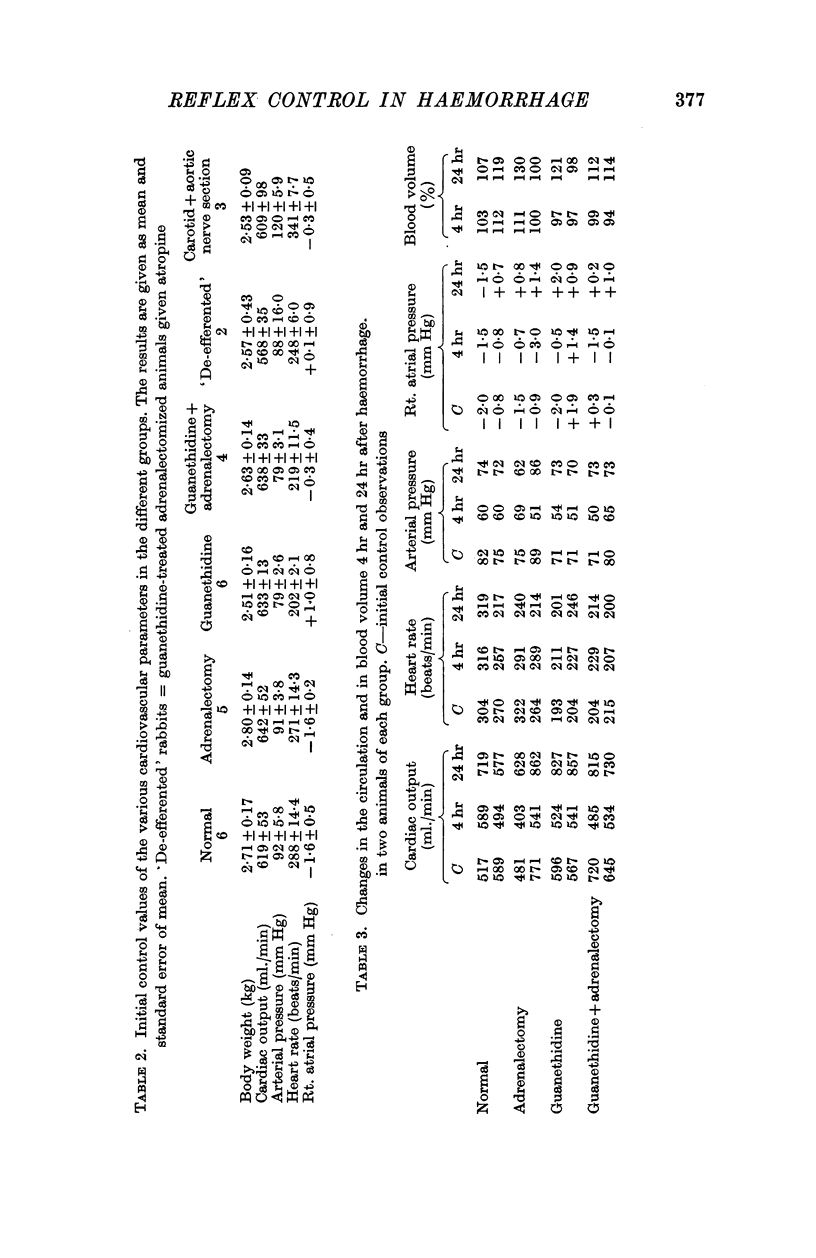
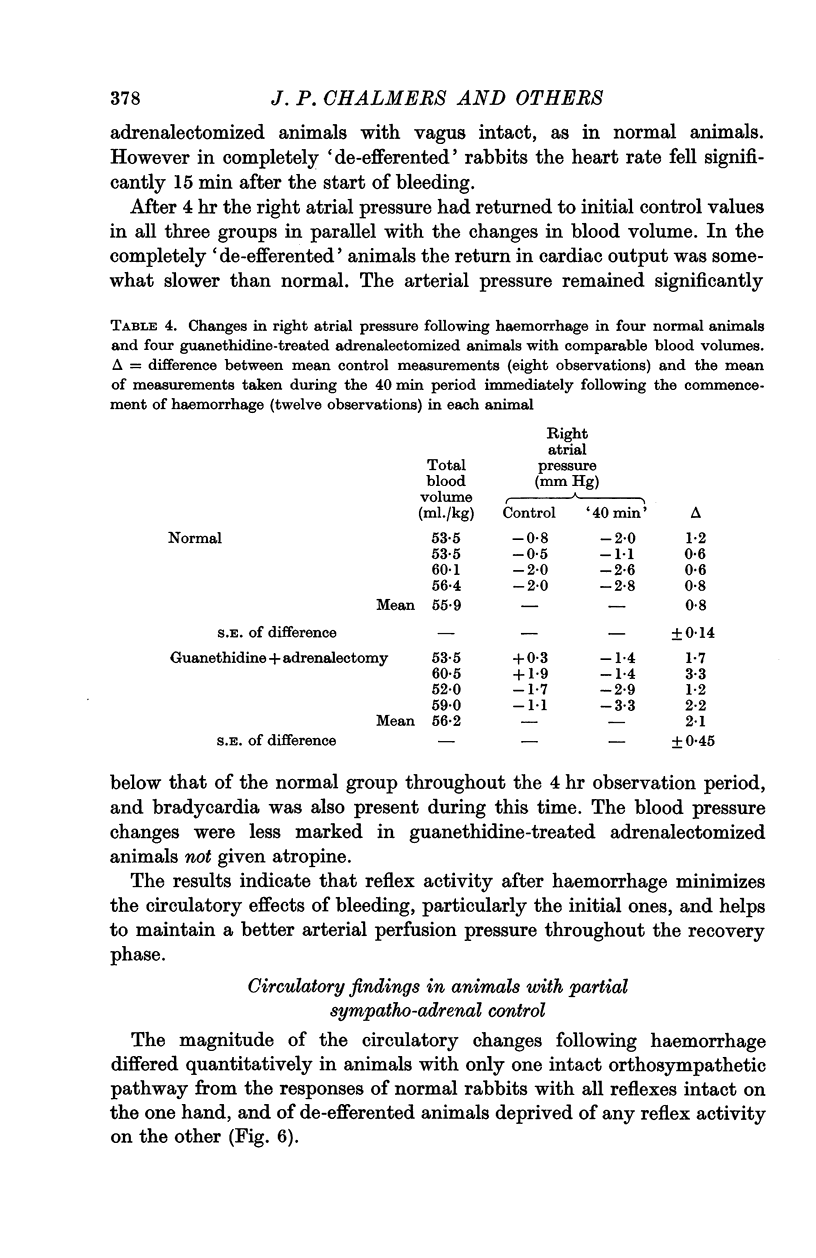
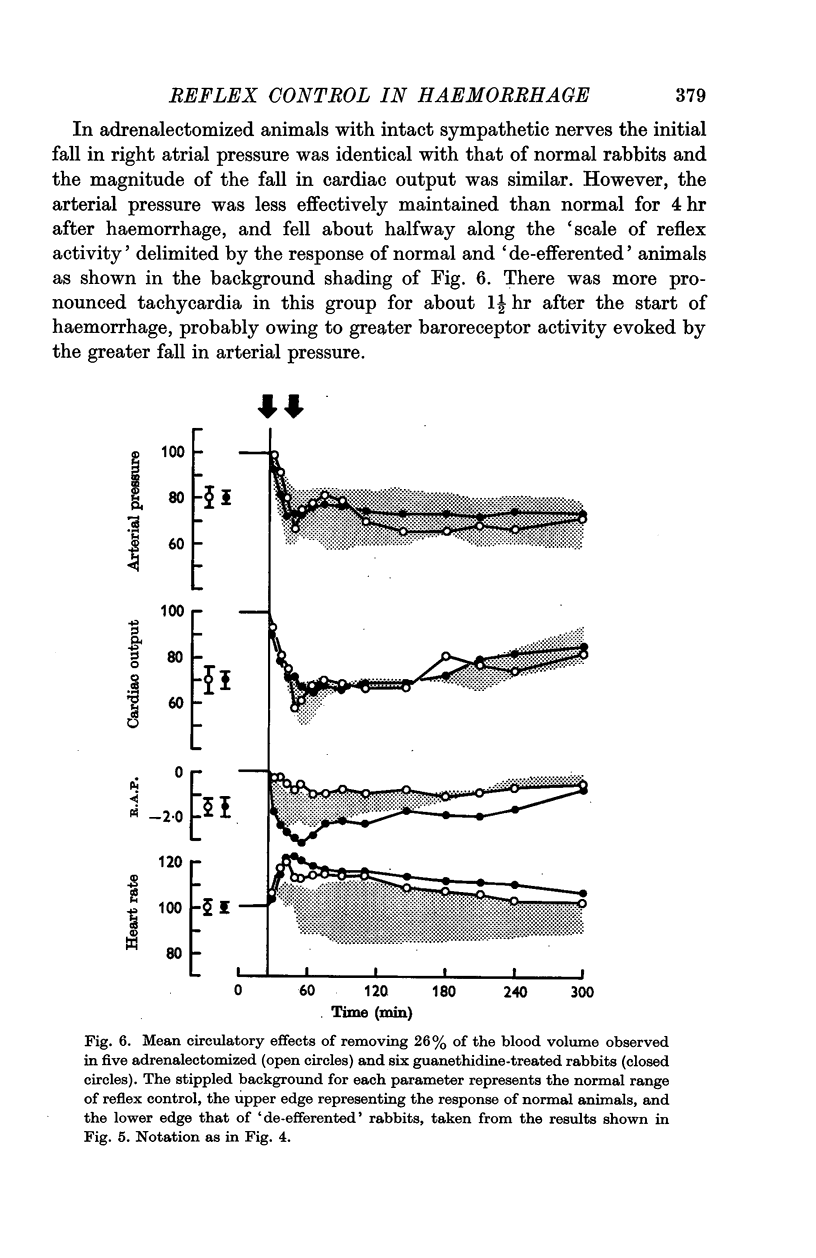
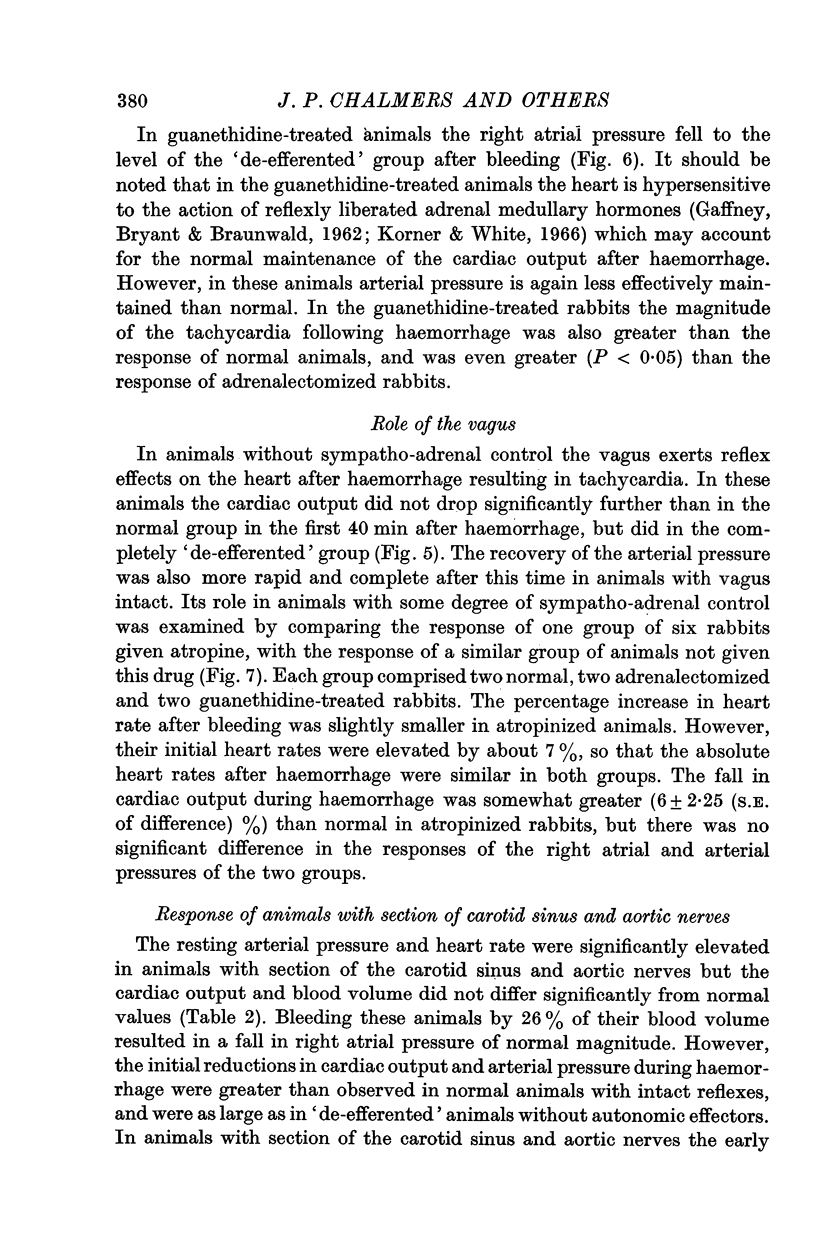
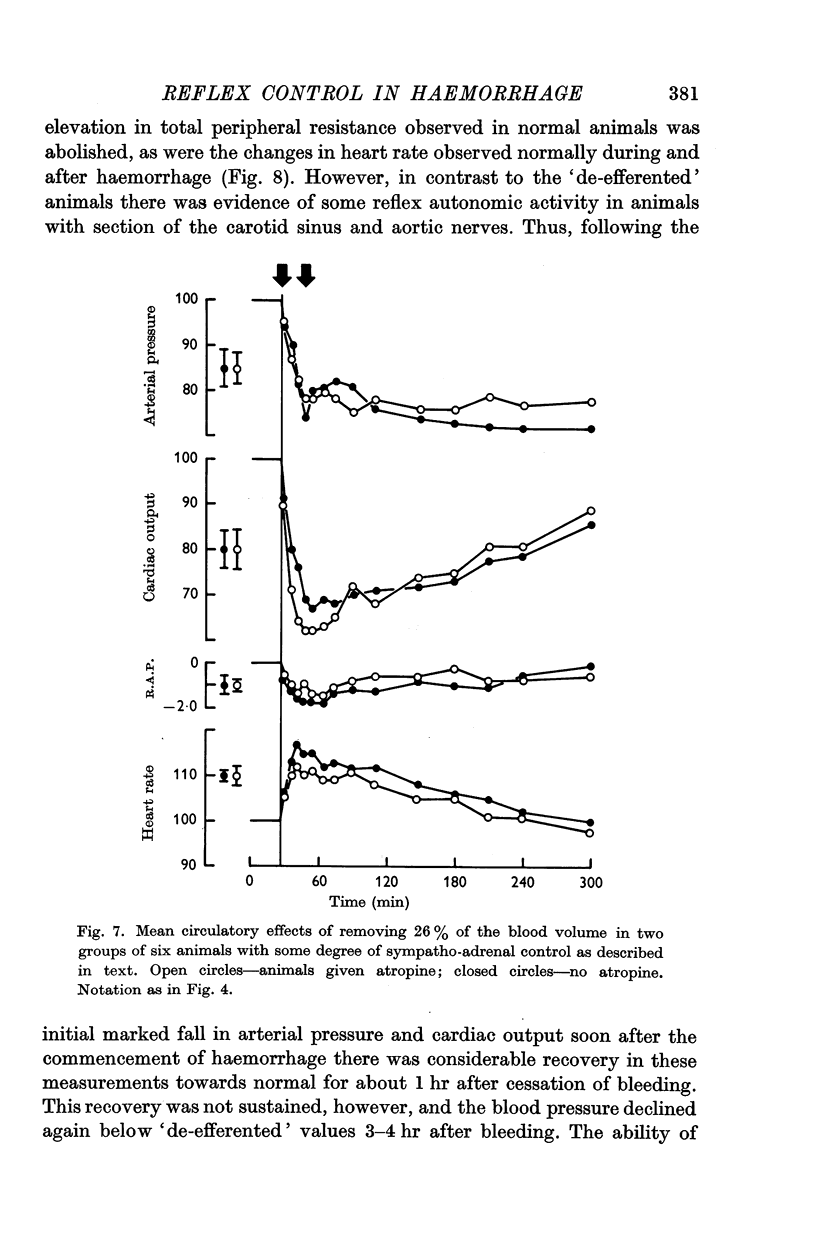
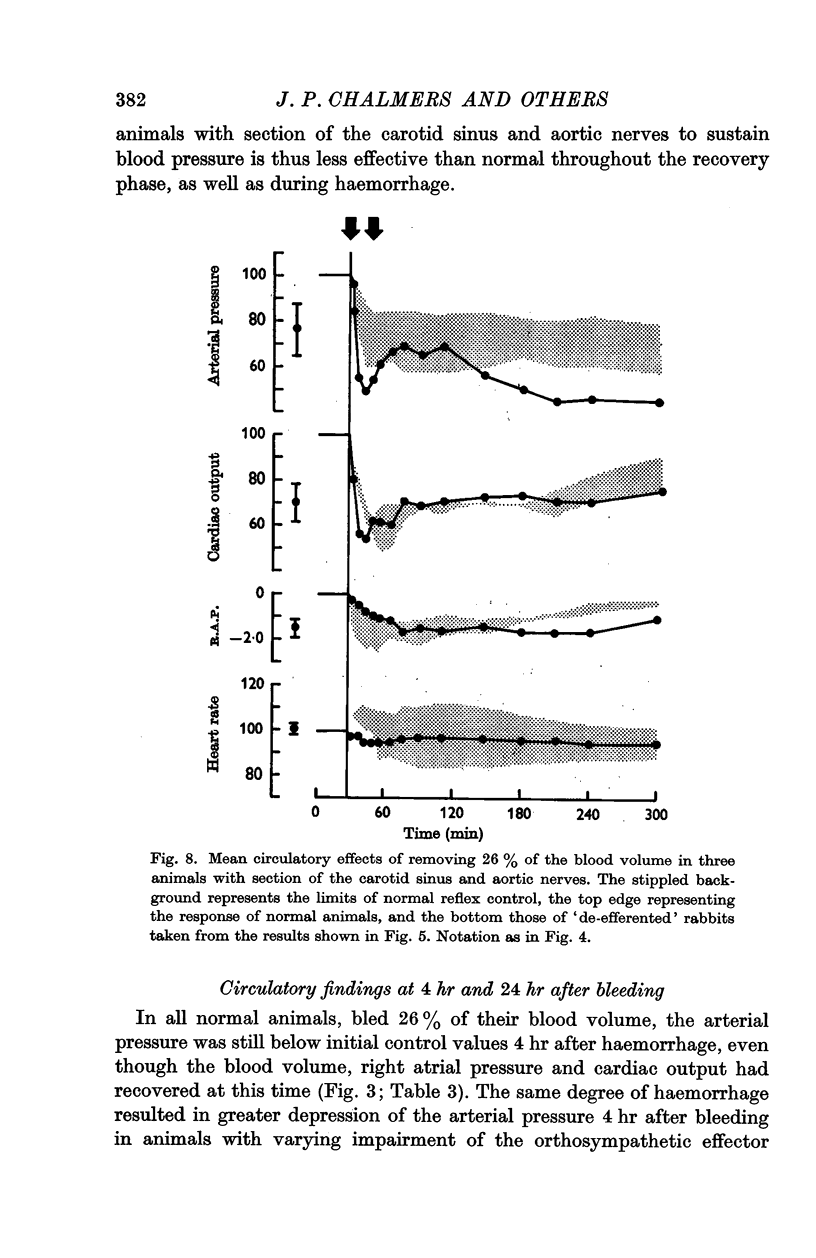
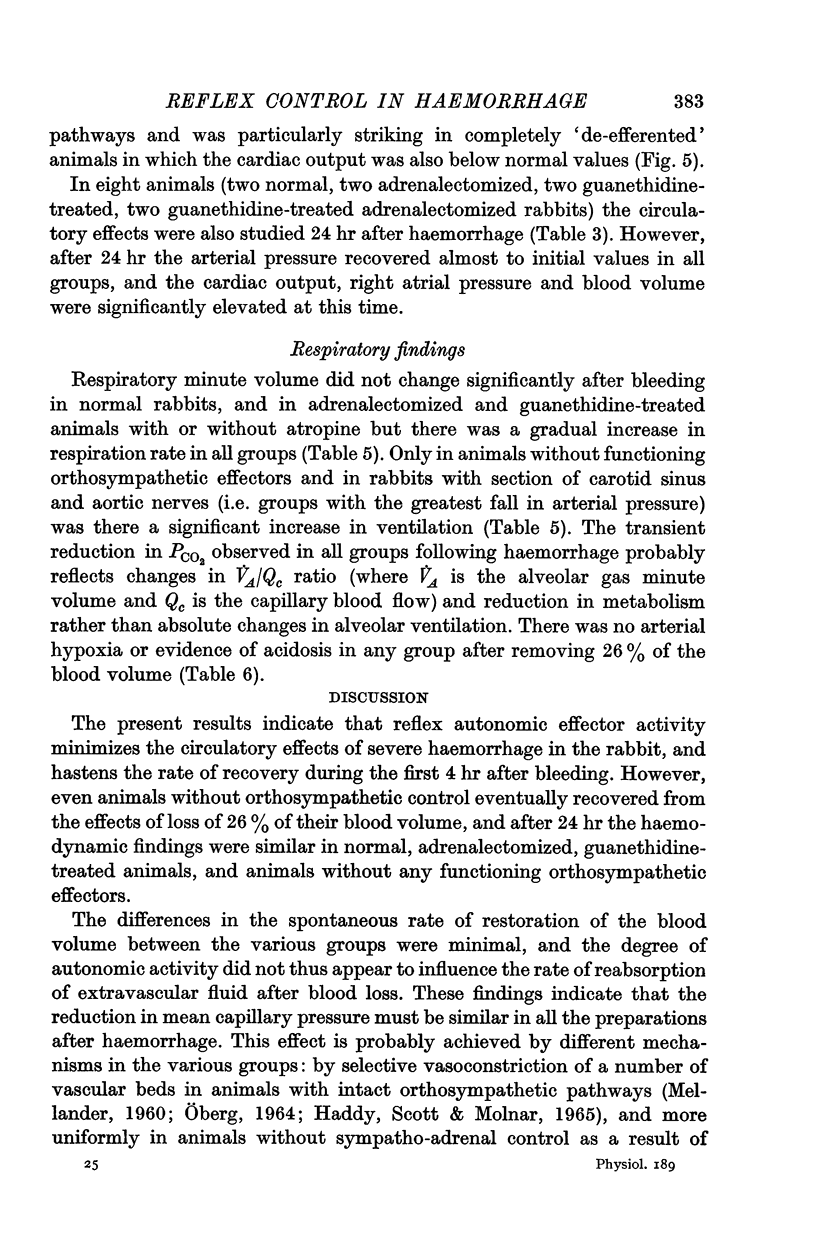
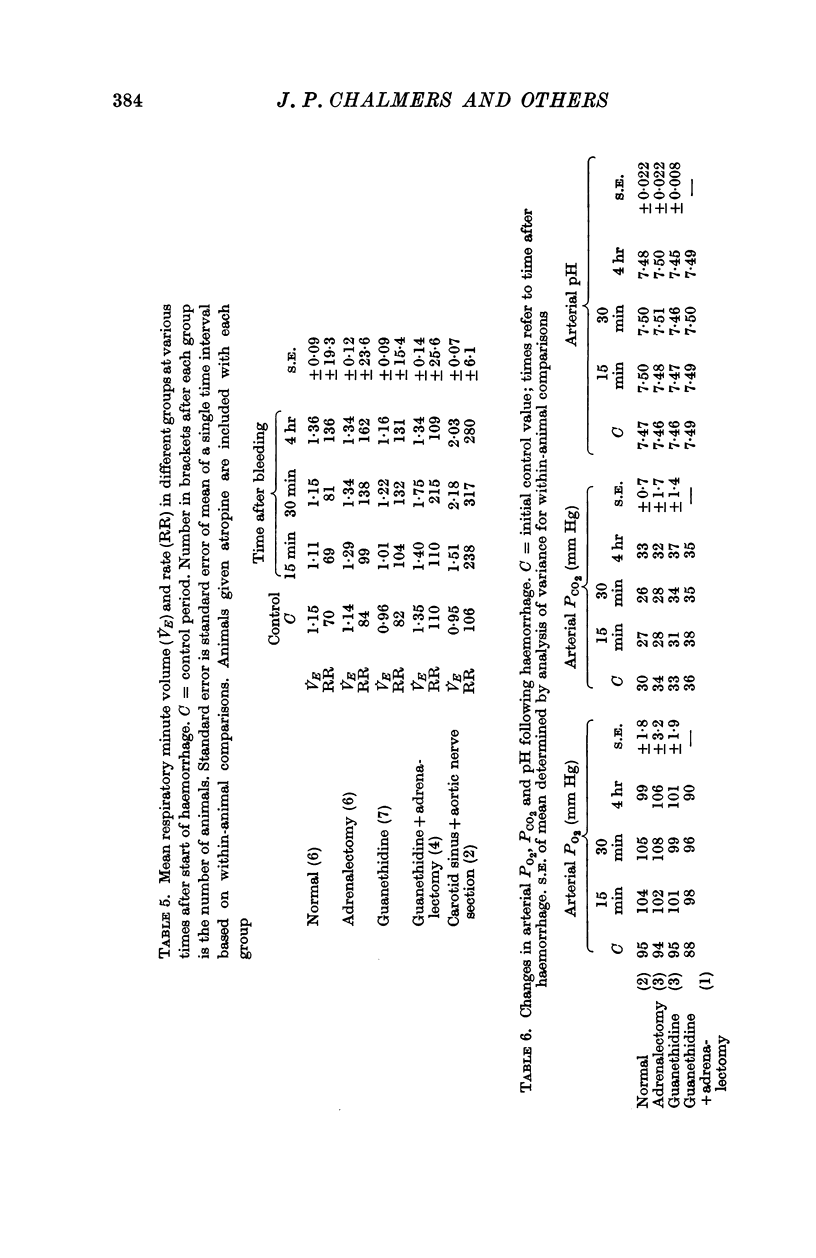
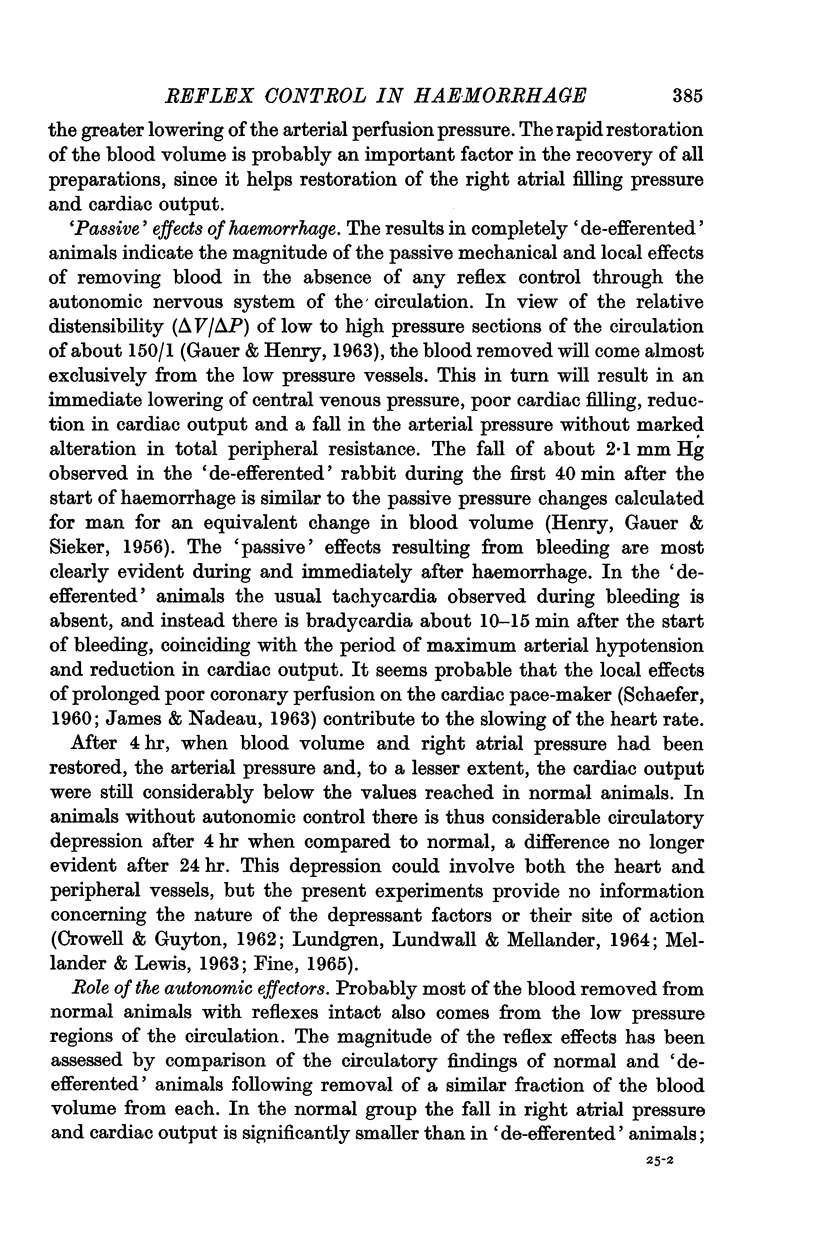
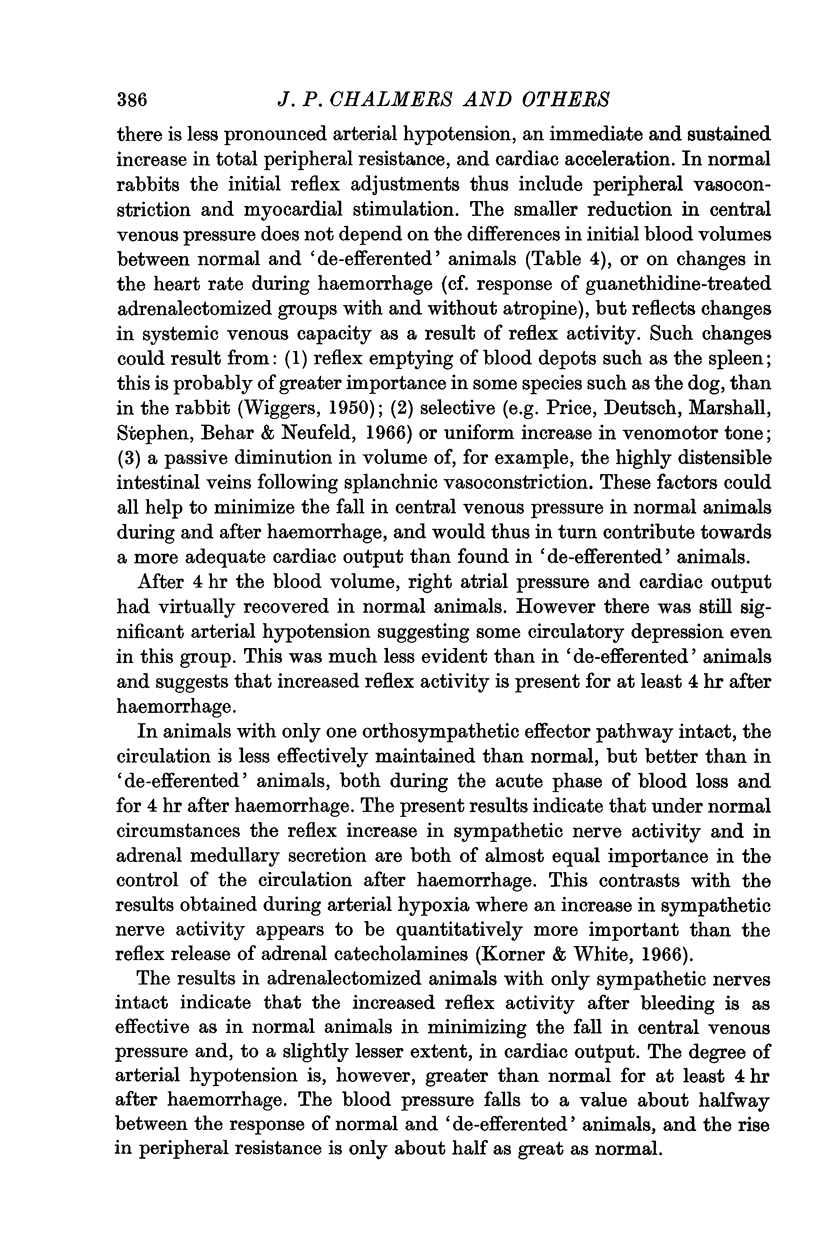
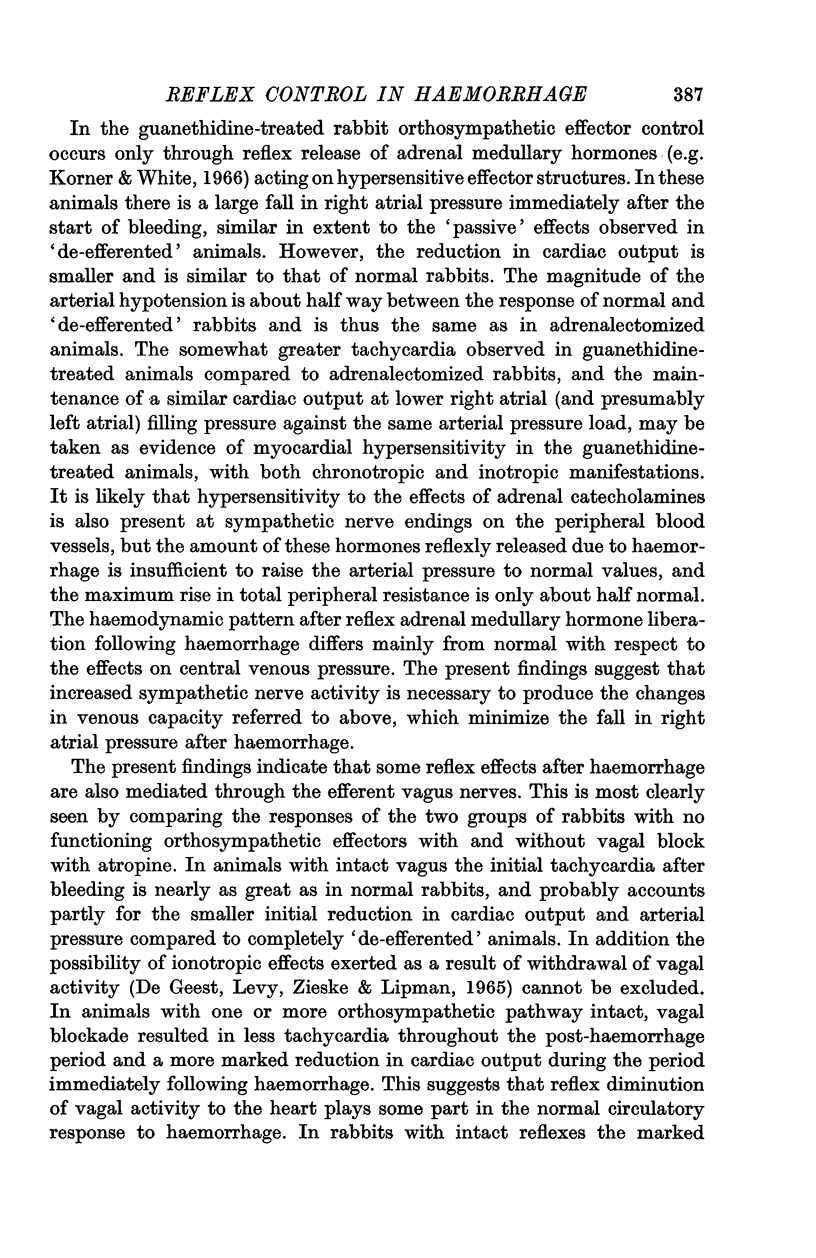
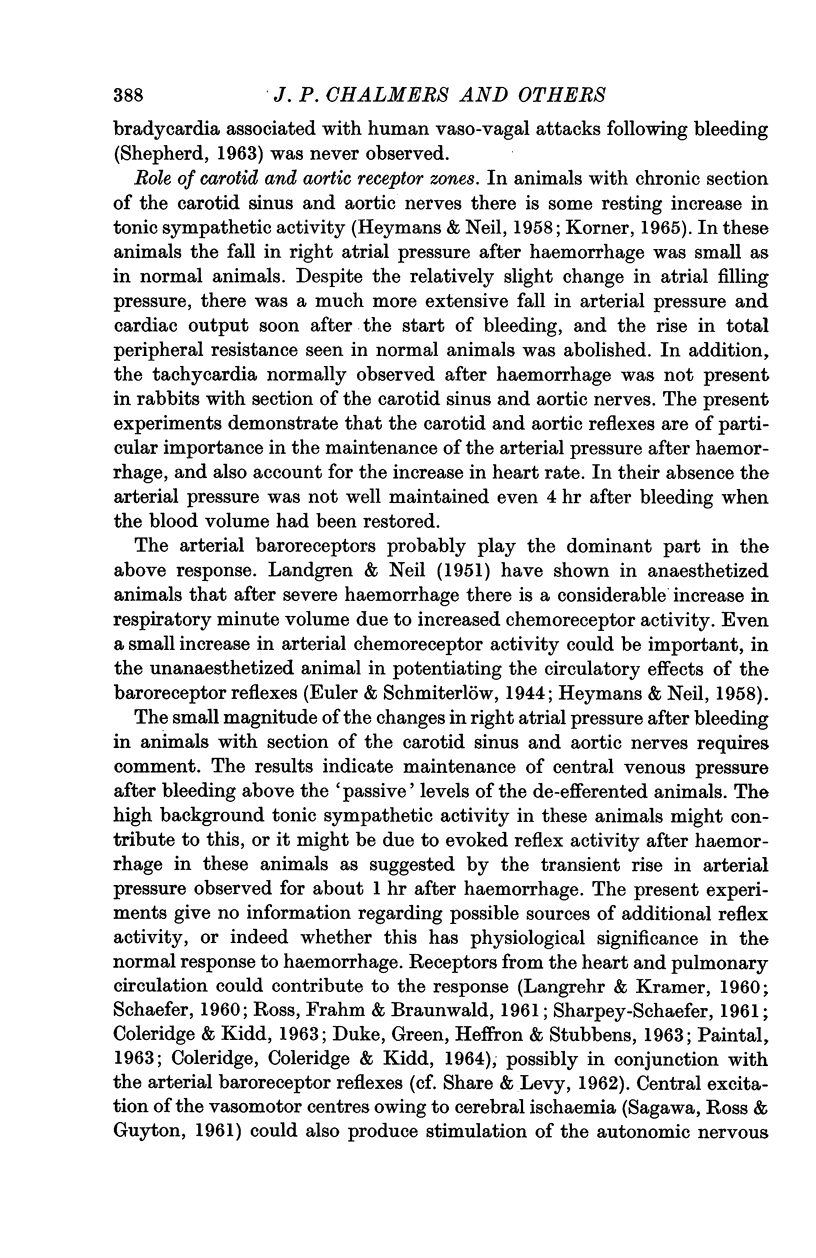
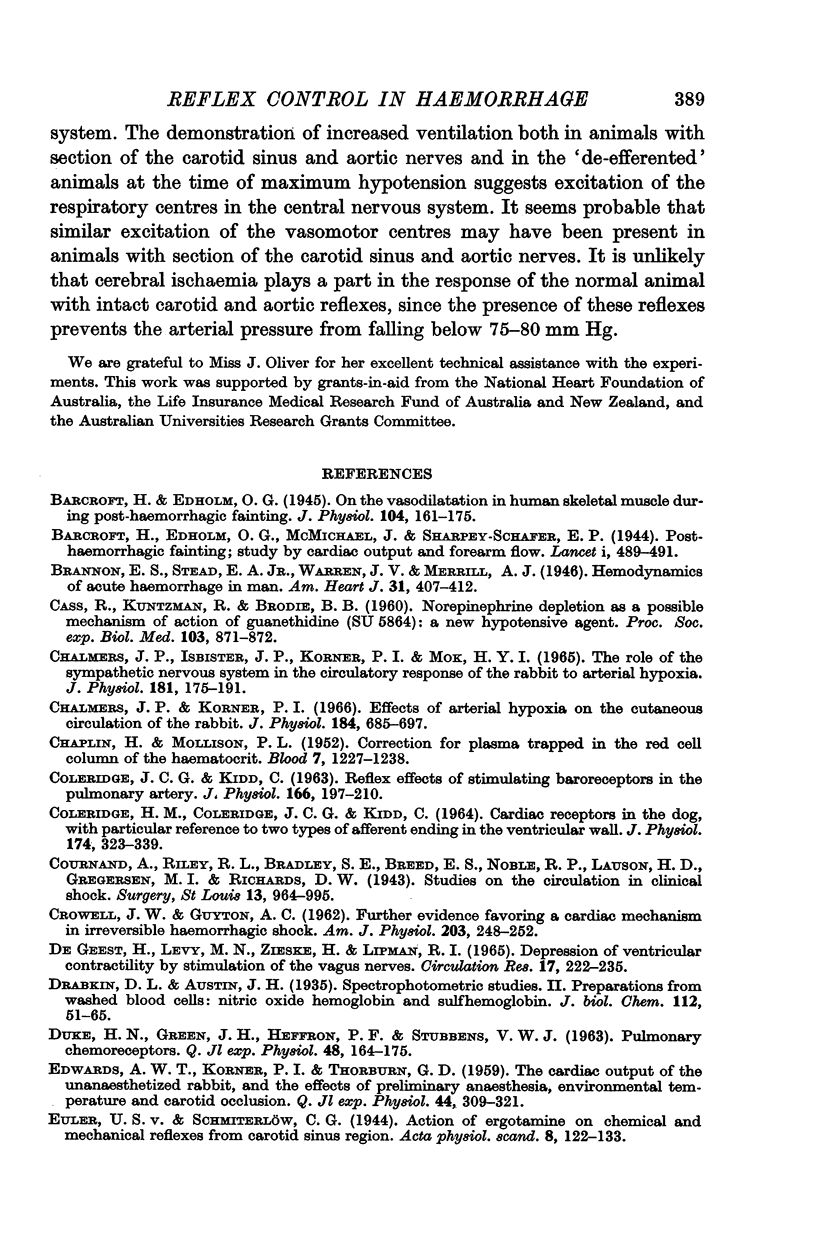
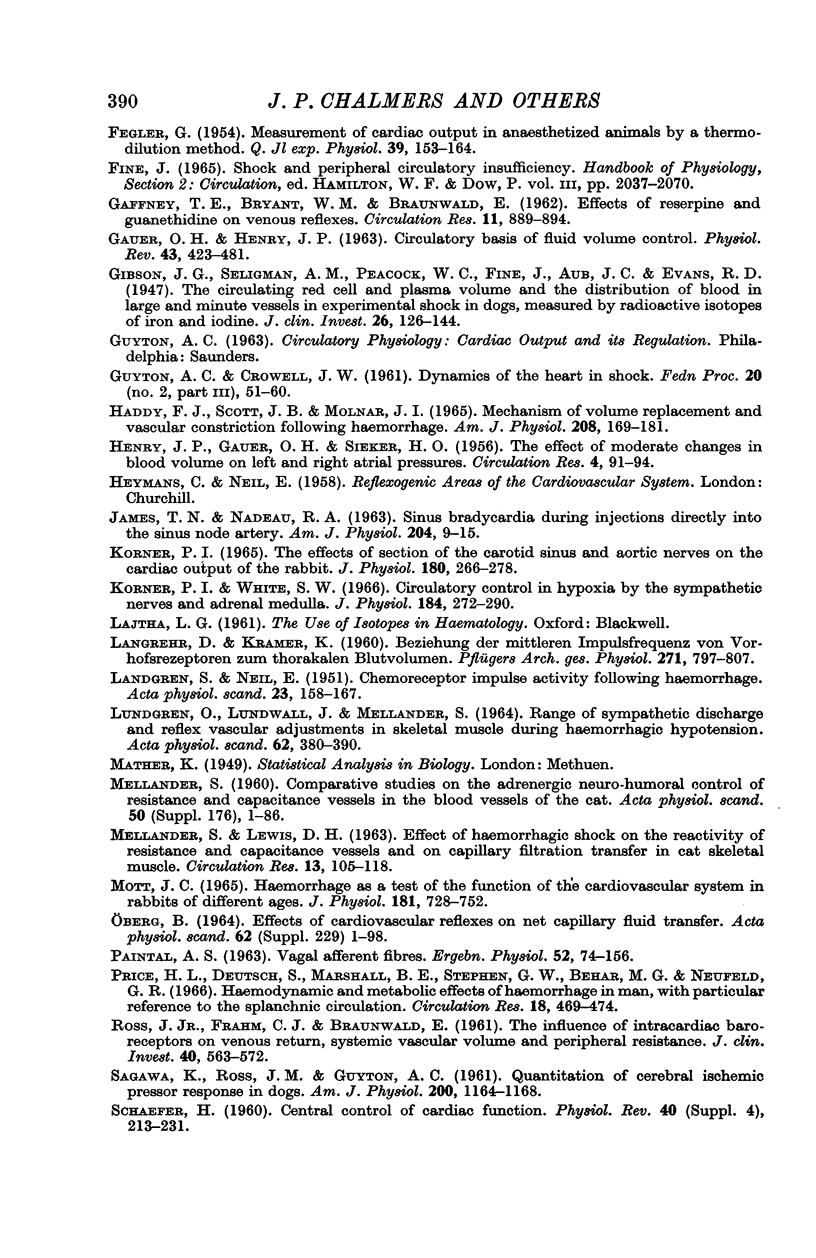
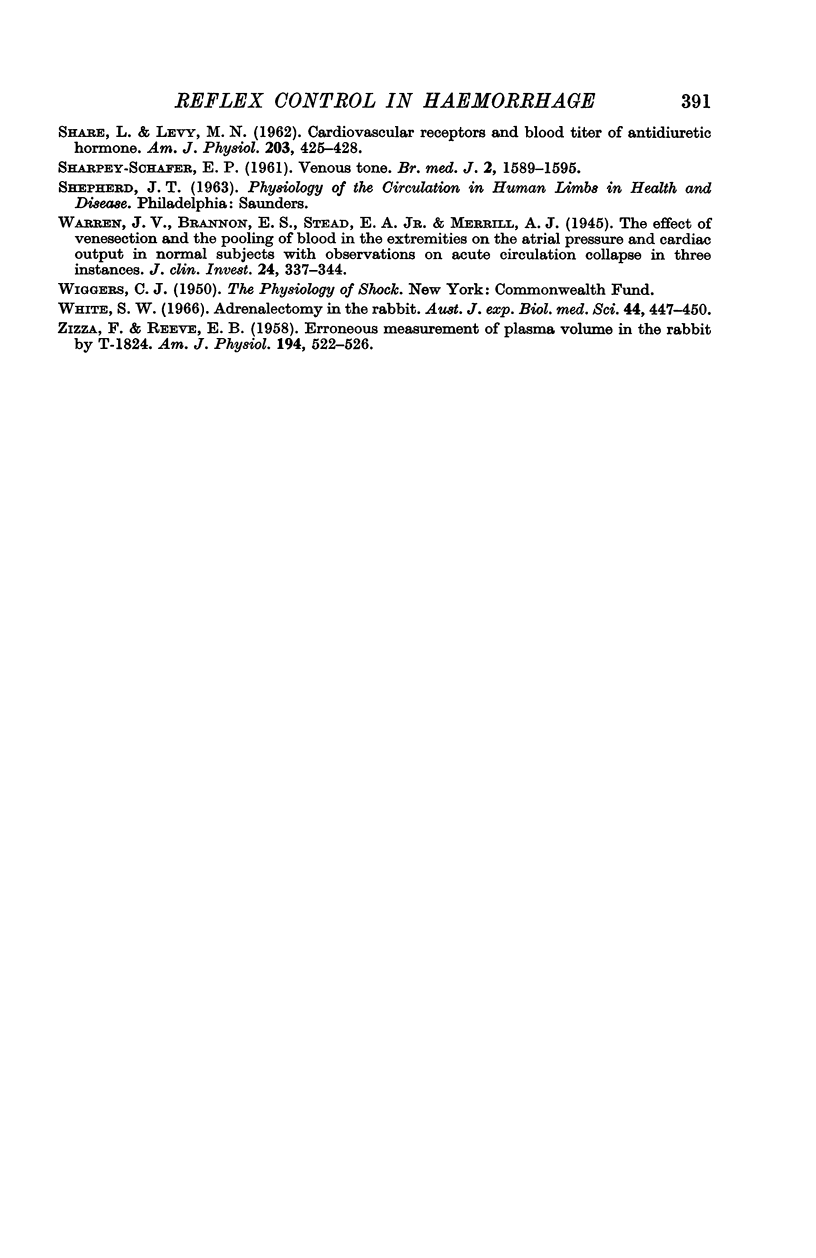
Selected References
These references are in PubMed. This may not be the complete list of references from this article.
- Barcroft H., Edholm O. G. On the vasodilatation in human skeletal muscle during post-haemorrhagic fainting. J Physiol. 1945 Oct 15;104(2):161–175. doi: 10.1113/jphysiol.1945.sp004113. [DOI] [PMC free article] [PubMed] [Google Scholar]
- CASS R., KUNTZMAN R., BRODIE B. B. Norepinephrine depletion as a possible mechanism of action of guanethidine (SU 5864), a new hypotensive agent. Proc Soc Exp Biol Med. 1960 Apr;103:871–872. doi: 10.3181/00379727-103-25702. [DOI] [PubMed] [Google Scholar]
- CHAPLIN H., Jr, MOLLISON P. L. Correction for plasma trapped in the red cell column of the hematocrit. Blood. 1952 Dec;7(12):1227–1238. [PubMed] [Google Scholar]
- COLERIDGE H. M., COLERIDGE J. C., KIDD C. CARDIAC RECEPTORS IN THE DOG, WITH PARTICULAR REFERENCE TO TWO TYPES OF AFFERENT ENDING IN THE VENTRICULAR WALL. J Physiol. 1964 Nov;174:323–339. doi: 10.1113/jphysiol.1964.sp007490. [DOI] [PMC free article] [PubMed] [Google Scholar]
- COLERIDGE J. C., KIDD C. Reflex effects of stimulating baroreceptors in the pulmonary artery. J Physiol. 1963 Apr;166:197–210. doi: 10.1113/jphysiol.1963.sp007100. [DOI] [PMC free article] [PubMed] [Google Scholar]
- CROWELL J. W., GUYTON A. C. Further evidence favoring a cardiac mechanism in irreversible hemorrhagic shock. Am J Physiol. 1962 Aug;203:248–252. doi: 10.1152/ajplegacy.1962.203.2.248. [DOI] [PubMed] [Google Scholar]
- Chalmers J. P., Isbister J. P., Korner P. I., Mok H. Y. The role of the sympathetic nervous system in the circulatory response of the rabbit to arterial hypoxia. J Physiol. 1965 Nov;181(1):175–191. doi: 10.1113/jphysiol.1965.sp007753. [DOI] [PMC free article] [PubMed] [Google Scholar]
- Chalmers J. P., Korner P. I. Effects of arterial hypoxia on the cutaneous circulation of the rabbit. J Physiol. 1966 Jun;184(3):685–697. doi: 10.1113/jphysiol.1966.sp007941. [DOI] [PMC free article] [PubMed] [Google Scholar]
- DEGEEST H., LEVY M. N., ZIESKE H., LIPMAN R. I. DEPRESSION OF VENTRICULAR CONTRACTILITY BY STIMULATION OF THE VAGUS NERVES. Circ Res. 1965 Sep;17:222–235. doi: 10.1161/01.res.17.3.222. [DOI] [PubMed] [Google Scholar]
- EDWARDS A. W., KORNER P. I., THORBURN G. D. The cardiac output of the unanaesthetized rabbit, and the effects of preliminary anaesthesia, environmental temperature and carotid occlusion. Q J Exp Physiol Cogn Med Sci. 1959 Jul;44:309–321. doi: 10.1113/expphysiol.1959.sp001403. [DOI] [PubMed] [Google Scholar]
- FEGLER G. Measurement of cardiac output in anaesthetized animals by a thermodilution method. Q J Exp Physiol Cogn Med Sci. 1954;39(3):153–164. doi: 10.1113/expphysiol.1954.sp001067. [DOI] [PubMed] [Google Scholar]
- GAFFNEY T. E., BRYANT W. M., BRAUNWALD E. Effects of reserpine and guanethidine on venous reflexes. Circ Res. 1962 Nov;11:889–894. doi: 10.1161/01.res.11.5.889. [DOI] [PubMed] [Google Scholar]
- GAUER O. H., HENRY J. P. Circulatory basis of fluid volume control. Physiol Rev. 1963 Jul;43:423–481. doi: 10.1152/physrev.1963.43.3.423. [DOI] [PubMed] [Google Scholar]
- GUYTON A. C., CROWELL J. W. Dynamics of the heartin shock. Fed Proc. 1961 Jul;20(Suppl 9):51–60. [PubMed] [Google Scholar]
- Gibson J. G., Seligman A. M., Peacock W. C., Fine J., Aub J. C., Evans R. D. THE CIRCULATING RED CELL AND PLASMA VOLUME AND THE DISTRIBUTION OF BLOOD IN LARGE AND MINUTE VESSELS IN EXPERIMENTAL SHOCK IN DOGS, MEASURED BY RADIOACTIVE ISOTOPES OF IRON AND IODINE. J Clin Invest. 1947 Jan;26(1):126–144. doi: 10.1172/JCI101785. [DOI] [PMC free article] [PubMed] [Google Scholar]
- HADDY F. J., SCOTT J. B., MOLNAR J. I. MECHANISM OF VOLUME REPLACEMENT AND VASCULAR CONSTRICTION FOLLOWING HEMORRHAGE. Am J Physiol. 1965 Jan;208:169–181. doi: 10.1152/ajplegacy.1965.208.1.169. [DOI] [PubMed] [Google Scholar]
- HENRY J. P., GAUER O. H., SIEKER H. O. The effect of moderate changes in blood volume on left and right atrial pressures. Circ Res. 1956 Jan;4(1):91–94. doi: 10.1161/01.res.4.1.91. [DOI] [PubMed] [Google Scholar]
- JAMES T. N., NADEAU R. A. Sinus bradycardia during injections directly into the sinus node artery. Am J Physiol. 1963 Jan;204:9–15. doi: 10.1152/ajplegacy.1963.204.1.9. [DOI] [PubMed] [Google Scholar]
- Korner P. I. The effect of section of the carotid sinus and aortic nerves on the cardiac output of the rabbit. J Physiol. 1965 Sep;180(2):266–278. doi: 10.1113/jphysiol.1965.sp007702. [DOI] [PMC free article] [PubMed] [Google Scholar]
- Korner P. I., White S. W. Circulatory control in hypoxia by the sympathetic nerves and adrenal medulla. J Physiol. 1966 May;184(2):272–290. doi: 10.1113/jphysiol.1966.sp007915. [DOI] [PMC free article] [PubMed] [Google Scholar]
- LANDGREN S., NEIL E. Chemoreceptor impulse activity following haemorrhage. Acta Physiol Scand. 1951 Aug 25;23(2-3):158–167. doi: 10.1111/j.1748-1716.1951.tb00805.x. [DOI] [PubMed] [Google Scholar]
- LANGREHR D., KRAMER K. [Relationships of median impulse frequency of the auricular receptors to the thoracic blood volume]. Pflugers Arch Gesamte Physiol Menschen Tiere. 1960;271:797–807. [PubMed] [Google Scholar]
- LUNDGREN O., LUNDWALL J., MELLANDER S. RANGE OF SYMPATHETIC DISCHARGE AND REFLEX VASCULAR ADJUSTMENTS IN SKELETAL MUSCLE DURING HEMORRHAGIC HYPOTENSION. Acta Physiol Scand. 1964 Dec;62:380–390. doi: 10.1111/j.1748-1716.1964.tb10436.x. [DOI] [PubMed] [Google Scholar]
- MELLANDER S. Comparative studies on the adrenergic neuro-hormonal control of resistance and capacitance blood vessels in the cat. Acta Physiol Scand Suppl. 1960;50(176):1–86. [PubMed] [Google Scholar]
- MELLANDER S., LEWIS D. H. EFFECT OF HEMORRHAGIC SHOCK ON THE REACTIVITY OF RESISTANCE AND CAPACITANCE VESSELS AND ON CAPILLARY FILTRATION TRANSFER IN CAT SKELETAL MUSCLE. Circ Res. 1963 Aug;13:105–118. doi: 10.1161/01.res.13.2.105. [DOI] [PubMed] [Google Scholar]
- Mott J. C. Haemorrhage as a test of the function of the cardiovascular system in rabbits of different ages. J Physiol. 1965 Dec;181(4):728–752. doi: 10.1113/jphysiol.1965.sp007794. [DOI] [PMC free article] [PubMed] [Google Scholar]
- PAINTAL A. S. VAGAL AFFERENT FIBRES. Ergeb Physiol. 1963;52:74–156. [PubMed] [Google Scholar]
- Price H. L., Deutsch S., Marshall B. E., Stephen G. W., Behar M. G., Neufeld G. R. Hemodynamic and metabolic effects of hemorrhage in man, with particular reference to the splanchnic circulation. Circ Res. 1966 May;18(5):469–474. doi: 10.1161/01.res.18.5.469. [DOI] [PubMed] [Google Scholar]
- Ross J., Frahm C. J., Braunwald E. THE INFLUENCE OF INTRACARDIAC BARORECEPTORS ON VENOUS RETURN, SYSTEMIC VASCULAR VOLUME AND PERIPHERAL RESISTANCE. J Clin Invest. 1961 Mar;40(3):563–572. doi: 10.1172/JCI104284. [DOI] [PMC free article] [PubMed] [Google Scholar]
- SAGAWA K., ROSS J. M., GUYTON A. C. Quantitation of cerebral ischemic pressor response in dogs. Am J Physiol. 1961 Jun;200:1164–1168. doi: 10.1152/ajplegacy.1961.200.6.1164. [DOI] [PubMed] [Google Scholar]
- SCHAEFER H. Central control of cardiac function. Physiol Rev Suppl. 1960 Apr;4:213–249. [PubMed] [Google Scholar]
- SHARE L., LEVY M. N. Cardiovascular receptors and blood titer of antidiuretic hormone. Am J Physiol. 1962 Sep;203:425–428. doi: 10.1152/ajplegacy.1962.203.3.425. [DOI] [PubMed] [Google Scholar]
- SHARPEY-SCHAFER E. P. Venous tone. Br Med J. 1961 Dec 16;2(5267):1589–1595. doi: 10.1136/bmj.2.5267.1589. [DOI] [PMC free article] [PubMed] [Google Scholar]
- Warren J. V., Brannon E. S., Stead E. A., Merrill A. J. THE EFFECT OF VENESECTION AND THE POOLING OF BLOOD IN THE EXTREMITIES ON THE ATRIAL PRESSURE AND CARDIAC OUTPUT IN NORMAL SUBJECTS WITH OBSERVATIONS ON ACUTE CIRCULATORY COLLAPSE IN THREE INSTANCES. J Clin Invest. 1945 May;24(3):337–344. doi: 10.1172/JCI101611. [DOI] [PMC free article] [PubMed] [Google Scholar]
- White S. W. Adrenalectomy in the rabbit. Aust J Exp Biol Med Sci. 1966 Aug;44(4):447–449. doi: 10.1038/icb.1966.41. [DOI] [PubMed] [Google Scholar]
- ZIZZA F., REEVE E. B. Erroneous measurement of plasma volume in the rabbit by T-1824. Am J Physiol. 1958 Sep;194(3):522–526. doi: 10.1152/ajplegacy.1958.194.3.522. [DOI] [PubMed] [Google Scholar]


